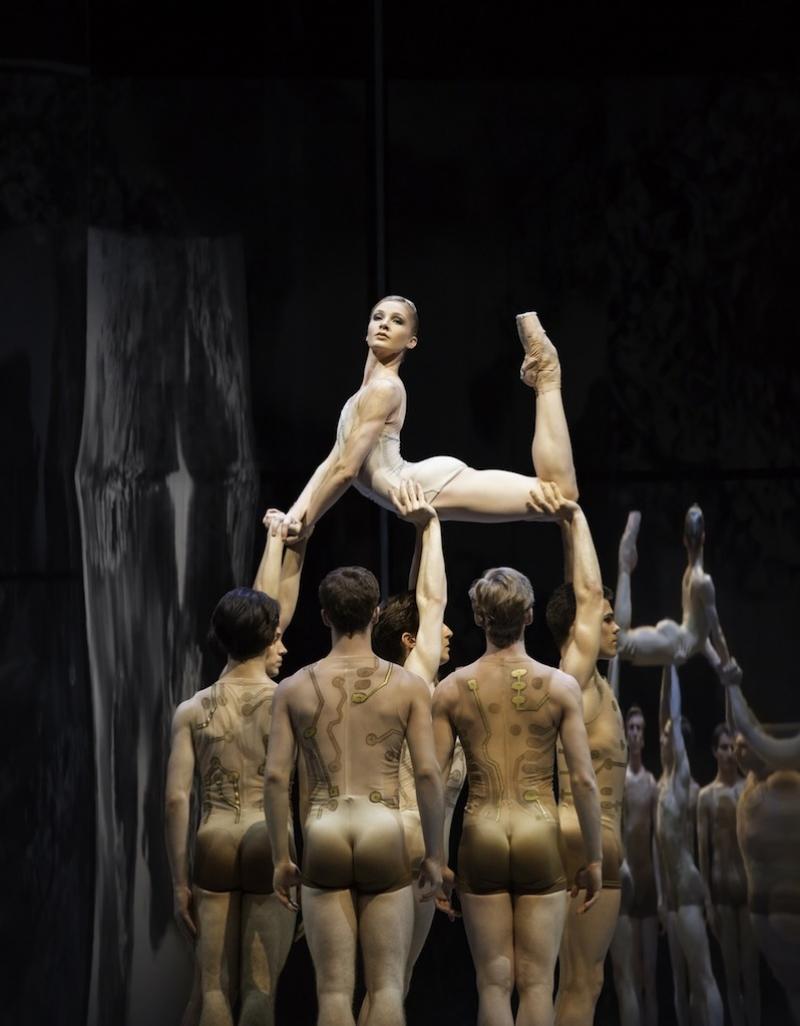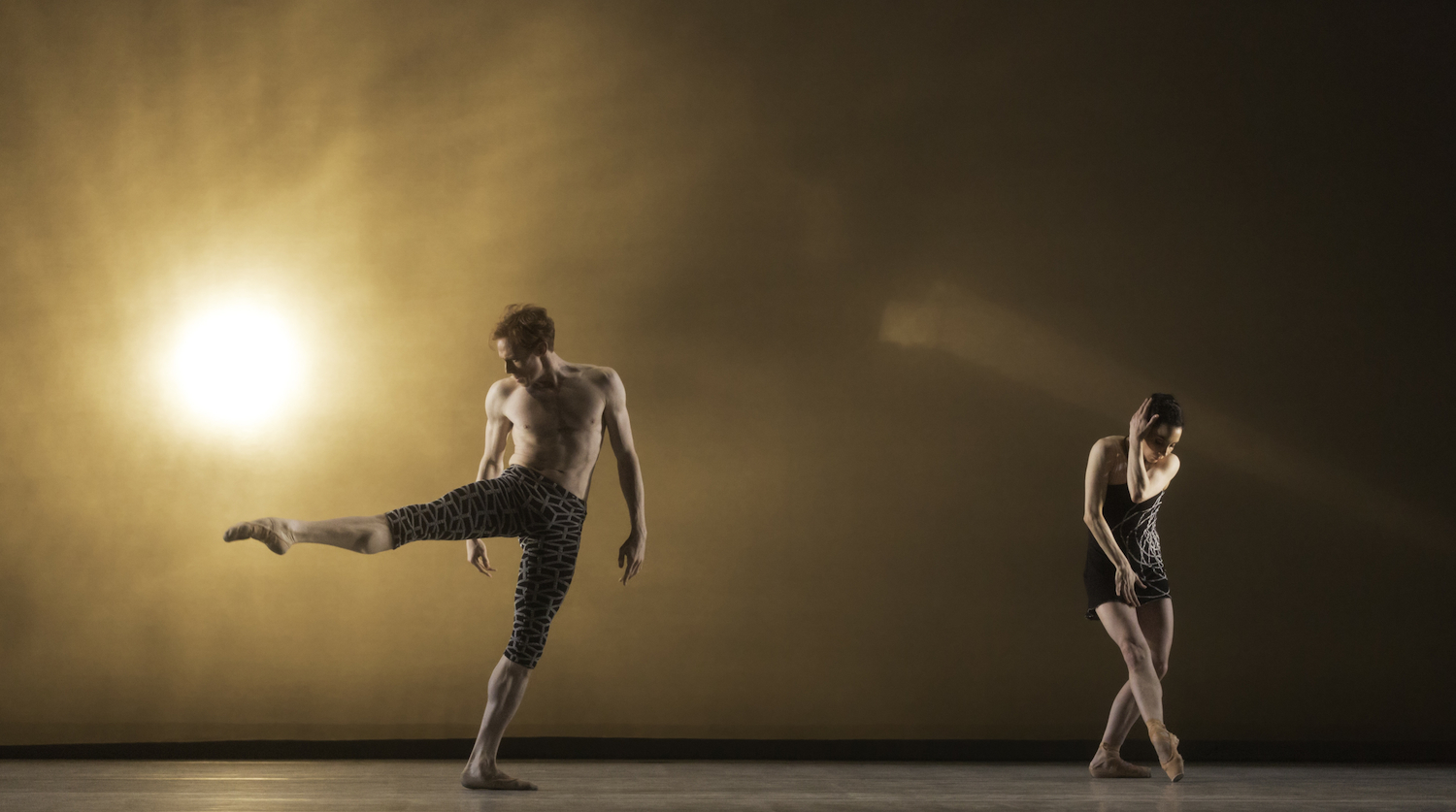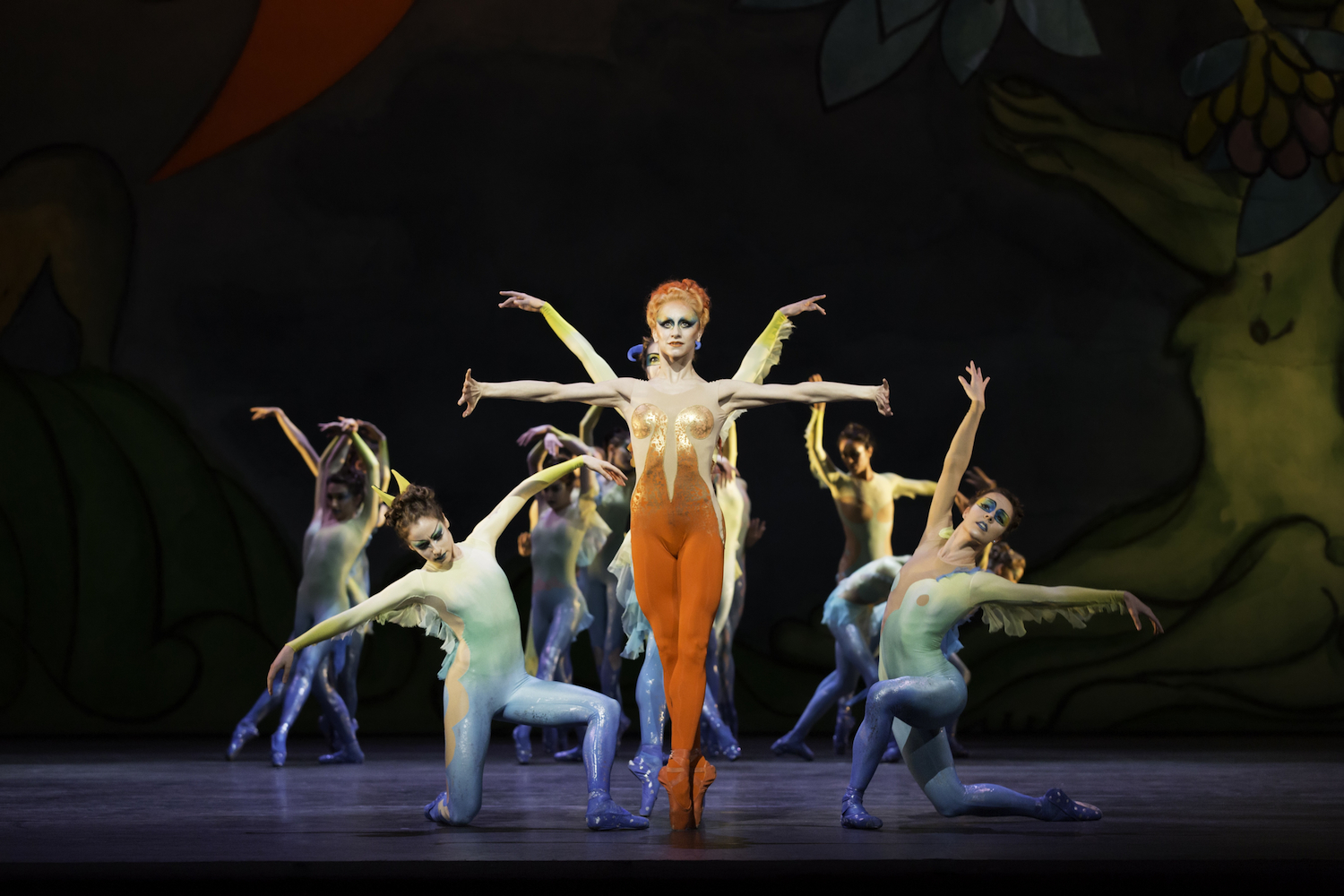Metamorphosis: Titian 2012, The Royal Ballet | reviews, news & interviews
Metamorphosis: Titian 2012, The Royal Ballet
Metamorphosis: Titian 2012, The Royal Ballet
A cross-platform party of dance, music and art as Dame Monica signs off

The bells ring out for creativity in the Royal Ballet’s final production under its outgoing director, Monica Mason, and the ambition at least of the enterprise is hugely to be cheered, even if asking seven choreographers to work together is on a hiding to nothing.
Metamorphosis: Titian 2012 is a cross-platform hybrid of too-rare provenance: it was germinated when the National Gallery asked three artists, Chris Ofili, Conrad Shawcross and Mark Wallinger, to make new work responding to the three great Titian paintings about Diana and Actaeon. (These centre on the myth of the huntsman Actaeon who saw the moon goddess Diana naked, and was transformed by her into a stag and ripped apart by his own hounds.)
The gallery also wanted the Royal Ballet to add a choreographic dimension - the Royal Opera House expanded the entire thing to embrace Mason’s departure with a ceremony of choreographers raised in her 10-year tenure, three new ballet scores commissioned from today’s composers, and stage designs from the artists related to their National Gallery artworks.
How do choreographers work together? Does one do the arms, the other the legs?
The result is three ballets, studded with stars, both among the creatives and among the performers. It would be too much to hope for three successes from such a complex venture, and with so many egos and big names competing for attention. Rather like Goldilocks, I thought one was too designy, one was too musicky, one was the right balance. Except that “too designy” and “too musicky” are compliments: the other elements didn’t match up.
Anyway, how do choreographers work together? Does one do the arms, the other the legs? Does one do the right side, the other the left? Merce Cunningham would roll a dice and leave it all to chance. Here, I imagine, there was a genteel but firm pecking order established, in which the leaders of the pack, Wayne McGregor and Christopher Wheeldon (who are to be equal in the Royal Ballet’s incoming new regime), would be kept separate, to maximise the chances of success.
From there, the other names would be diplomatically dealt, resulting in the guest worker Kim Brandstrup - the most different from McGregor - being put with him, and the proven in-house talents, Liam Scarlett and Will Tuckett, given the third section, with the lesser Alastair Marriott and Jonathan Watkins added to have the whole pack in play.
The choreographic result of this deal: a pair of kings in the first hand, with Brandstrup and McGregor, king-high in the second, being Wheeldon and Marriott, and a flush draw, Scarlett, Tuckett, Watkins, waiting eagerly for the turn and river cards, the composer and designer. Getting Chris Ofili for their designer seemed to give the final section a betting hand, the middle one looked set for a big win with Mark-Anthony Turnage for their composer. But then as luck would have it, Mark Wallinger’s designs for the middle piece looked like something from European Bathrooms UK and Jonathan Dove’s music for the third was sub-Carmina Burana. The question was which would cohere.

Above: Edward Watson and Tamara Rojo in Machina, before the screen dissolves to show the robotic machine
Whereas the opening work, Machina, found McGregor, Brandstrup, Nico Muhly and Conrad Shawcross co-creating an elusive, emotionally shadowy piece that gave Carlos Acosta, Leanne Benjamin, Tamara Rojo and Edward Watson meaty duet work from both these well-tuned and exceedingly different choreographers, grave and warm from Brandstrup, breezy and sharp from McGregor. Behind them, courtesy of Shawcross, strange light effects dissolved to reveal a gigantic robot, part moon-lander, part hydraulic medieval gauntlet, which brandished a dangerous light-wand over the stage as if searching for humans to taser. It is said that it is programmed by computer software derived from Watson dancing McGregor - this seems an unnecessary expense on something that looked as if it was manipulated by your usual iffy remote control.
It was a fine celebration with which to wish for a metamorphosis of the Royal Ballet from a smart museum to a creative powerhouse again
Muhly sought a baroque mood in the music, gradually dissolving the lamenting chordal strings with increasingly percussive piano. Benjamin twisted and turned like a double helix in the strong arms of Acosta, probably McGregor’s writing. Rojo and Watson conjured up a powerfully intimate tenderness together in the closing duet, probably Brandstrup’s. I’d like to see this piece again.
I’d like to hear the next one again. Wheeldon and Marriott had to be much more musically alert than any of the other choreographers due to the fiercely arrhythmic demands of Turnage’s score for Trespass, a series of boldly contrasted episodes, through which the dancers in pallid nude-effect costumes and within a tall plexiglass shower screen either caught the eye in firmly etched duets and solos (a couple of which looked like the musical Wheeldon) or made the lids droop over prim trotting ensembles.
The sharpest section was all-girls, with Melissa Hamilton in sinewy stride as Diana bathing among her nymphs, and then ascending in moon shapes in the hands of her attendants, wiggling her toes invitingly. None of the choreography has much of the fleshiness of Titian upon it. That comes from the fleeting shape-making of moon-horns and stag-horns, and from the music. If Muhly’s score is “ballet" music, underpinning Machina's elements, Turnage’s demands centre-stage. It's not dansante in physical terms but it’s compellingly virtuosic, a dance upon the ear with big handfuls of yummy textures, chandeliers of high Britten-ish arpeggios, sustained string incantations, rhumba beats, tangos and some kind of zither among a blizzard of atmospheric effects.
 Ofili’s vivid, carnival set is the one good thing about the third one, Diana and Actaeon, though his costumes are awful. This work had drawn the short straw, not only yoking three less well-formed choreographers together, but being apparently requested by Mason to narrate the story, as the other two works were not doing so. The result, a frightful old-fashioned dramballet of Soviet type, with an over-sugary, Orff-colour cantata from Dove, from which the high soprano Kim Sheehan extracted the best juices. Poor Marianela Nuñez (pictured right) is sheathed in a fiery leotard that minimises her boobs and maximises her bottom, stalking about in night-club orange hair, striking declamatory arabesques, and terrorising the daylights out of nice Federico Bonelli, who appears to have strayed in from Giselle. His mimed death by hounddogs won't really do for these days.
Ofili’s vivid, carnival set is the one good thing about the third one, Diana and Actaeon, though his costumes are awful. This work had drawn the short straw, not only yoking three less well-formed choreographers together, but being apparently requested by Mason to narrate the story, as the other two works were not doing so. The result, a frightful old-fashioned dramballet of Soviet type, with an over-sugary, Orff-colour cantata from Dove, from which the high soprano Kim Sheehan extracted the best juices. Poor Marianela Nuñez (pictured right) is sheathed in a fiery leotard that minimises her boobs and maximises her bottom, stalking about in night-club orange hair, striking declamatory arabesques, and terrorising the daylights out of nice Federico Bonelli, who appears to have strayed in from Giselle. His mimed death by hounddogs won't really do for these days.
Admiration for the orchestra, with three busy new half-hour scores to learn and play under three conductors (a storm of conductors infecting London at the moment - four of them over in the Albert Hall for the Proms’ first night), and making two of them sound on first hearing like really valuable new additions.
Dame Monica took a curtain call bouncing in delight at what had been done, stars and creatives all massed on stage around her. It was a fine way to party, and a fine celebration with which to wish for a metamorphosis of the Royal Ballet from a smart museum to a creative powerhouse again. Seven choreographers? Many ballet companies are lucky to have two. Goodbye to the past; roll on, the next party.
Watch the Royal Opera House's trailer for the making of Metamorphosis: Titian 2012
rating
Share this article
The future of Arts Journalism
You can stop theartsdesk.com closing!
We urgently need financing to survive. Our fundraising drive has thus far raised £49,000 but we need to reach £100,000 or we will be forced to close. Please contribute here: https://gofund.me/c3f6033d
And if you can forward this information to anyone who might assist, we’d be grateful.

Subscribe to theartsdesk.com
Thank you for continuing to read our work on theartsdesk.com. For unlimited access to every article in its entirety, including our archive of more than 15,000 pieces, we're asking for £5 per month or £40 per year. We feel it's a very good deal, and hope you do too.
To take a subscription now simply click here.
And if you're looking for that extra gift for a friend or family member, why not treat them to a theartsdesk.com gift subscription?
more Dance
 'We are bowled over!' Thank you for your messages of love and support
Much-appreciated words of commendation from readers and the cultural community
'We are bowled over!' Thank you for your messages of love and support
Much-appreciated words of commendation from readers and the cultural community
 R:Evolution, English National Ballet, Sadler's Wells review - a vibrant survey of ballet in four acts
ENB set the bar high with this mixed bill, but they meet its challenges thrillingly
R:Evolution, English National Ballet, Sadler's Wells review - a vibrant survey of ballet in four acts
ENB set the bar high with this mixed bill, but they meet its challenges thrillingly
 Like Water for Chocolate, Royal Ballet review - splendid dancing and sets, but there's too much plot
Christopher Wheeldon's version looks great but is too muddling to connect with fully
Like Water for Chocolate, Royal Ballet review - splendid dancing and sets, but there's too much plot
Christopher Wheeldon's version looks great but is too muddling to connect with fully
 iD-Reloaded, Cirque Éloize, Marlowe Theatre, Canterbury review - attitude, energy and invention
A riotous blend of urban dance music, hip hop and contemporary circus
iD-Reloaded, Cirque Éloize, Marlowe Theatre, Canterbury review - attitude, energy and invention
A riotous blend of urban dance music, hip hop and contemporary circus
 How to be a Dancer in 72,000 Easy Lessons, Teaċ Daṁsa review - a riveting account of a life in dance
Michael Keegan-Dolan's unique hybrid of physical theatre and comic monologue
How to be a Dancer in 72,000 Easy Lessons, Teaċ Daṁsa review - a riveting account of a life in dance
Michael Keegan-Dolan's unique hybrid of physical theatre and comic monologue
 A Single Man, Linbury Theatre review - an anatomy of melancholy, with breaks in the clouds
Ed Watson and Jonathan Goddard are extraordinary in Jonathan Watkins' dance theatre adaptation of Isherwood's novel
A Single Man, Linbury Theatre review - an anatomy of melancholy, with breaks in the clouds
Ed Watson and Jonathan Goddard are extraordinary in Jonathan Watkins' dance theatre adaptation of Isherwood's novel
 Peaky Blinders: The Redemption of Thomas Shelby, Rambert, Sadler's Wells review - exciting dancing, if you can see it
Six TV series reduced to 100 minutes' dance time doesn't quite compute
Peaky Blinders: The Redemption of Thomas Shelby, Rambert, Sadler's Wells review - exciting dancing, if you can see it
Six TV series reduced to 100 minutes' dance time doesn't quite compute
 Giselle, National Ballet of Japan review - return of a classic, refreshed and impeccably danced
First visit by Miyako Yoshida's company leaves you wanting more
Giselle, National Ballet of Japan review - return of a classic, refreshed and impeccably danced
First visit by Miyako Yoshida's company leaves you wanting more
 Quadrophenia, Sadler's Wells review - missed opportunity to give new stage life to a Who classic
The brilliant cast need a tighter score and a stronger narrative
Quadrophenia, Sadler's Wells review - missed opportunity to give new stage life to a Who classic
The brilliant cast need a tighter score and a stronger narrative
 The Midnight Bell, Sadler's Wells review - a first reprise for one of Matthew Bourne's most compelling shows to date
The after-hours lives of the sad and lonely are drawn with compassion, originality and skill
The Midnight Bell, Sadler's Wells review - a first reprise for one of Matthew Bourne's most compelling shows to date
The after-hours lives of the sad and lonely are drawn with compassion, originality and skill
 Ballet to Broadway: Wheeldon Works, Royal Ballet review - the impressive range and reach of Christopher Wheeldon's craft
The title says it: as dancemaker, as creative magnet, the man clearly works his socks off
Ballet to Broadway: Wheeldon Works, Royal Ballet review - the impressive range and reach of Christopher Wheeldon's craft
The title says it: as dancemaker, as creative magnet, the man clearly works his socks off
 The Forsythe Programme, English National Ballet review - brains, beauty and bravura
Once again the veteran choreographer and maverick William Forsythe raises ENB's game
The Forsythe Programme, English National Ballet review - brains, beauty and bravura
Once again the veteran choreographer and maverick William Forsythe raises ENB's game

Add comment